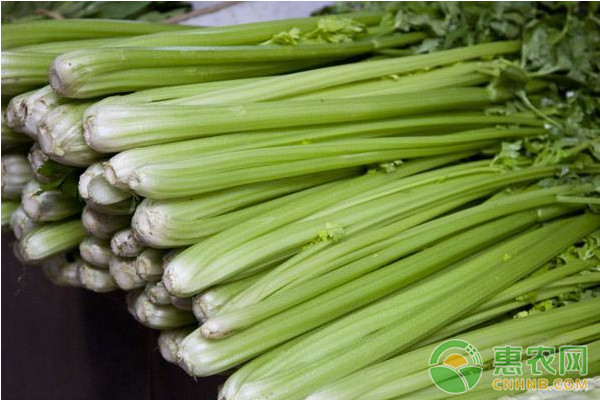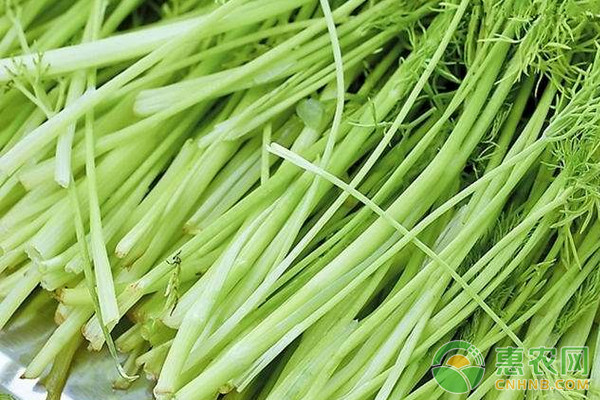How is celery cultivated? Celery and parsley are among the vegetables that people love and are afraid of, but there are still many people who like to eat celery. Celery leaves are very beneficial for preventing hypertension and arteriosclerosis, and have an auxiliary therapeutic effect. Today, Xiaobian will organize a high-yield cultivation technique for celery.

1. Select a plot
The terrain is flat, the drainage is convenient, the texture is fertile and loose, and the plots of umbelliferous plants such as celery and coriander have not been planted for seedlings. Generally, a planting area of ​​50 m is required for planting one mu of celery. Before the preparation of the land, 500 kg of composted organic fertilizer and 2.5 kg of high-quality potassium sulfate compound fertilizer were applied to the nursery. After ploughing and turning, it is made into a width of 1.5m and a length of about 35m.
2. Seed selection
Celery has two kinds of celery (Chinese type) and celery. The former has a slender petiole and the latter has a wide and thick petiole. In production, we should choose strong adaptability, disease resistance, high yield, and meet the local market demand and consumption taste. The city is mainly made up of American celery, glass crisp, Ventura, and Statue of Liberty.
3. Seed treatment
Wash the seeds with water first, then soak them in 48 °C hot water for 30 min, stir constantly and keep the temperature. Then put it in cold water for 5~10min, then soak it in normal temperature for 24h, wash it several times after watering out, gently rub it with your hands, and open the epidermis until the seed is scattered. When spreading to the surface of the seed and drying it, mix the fine sand with 5 times the seed volume, put it into a clean pot, cover the plastic film, and germination at 18~20 °C. Flip 1 or 2 times a day to increase ventilation and let the seeds see the light. At the same time, wash 5~7 times with cold water every day. When 80% of the seeds are germinated, they can be sown.
4. Sowing
Establish a seedbed, deep ploughing, apply enough base fertilizer, level the trampoline before sowing, then pour the water to the bottom of the foot, wait until the water is fully infiltrated, and sow 100~150 g per 70 m seedbed. Because the seeds can be mixed with fine sand and then covered with 3~4 mm of nutrient soil, because the seed top soil is weak, the soil should not be too thick. After sowing, cover a layer of mulch film, pay attention to management, so as not to hurt the seedlings.
5. Colonization
The localization time can be selected according to the local climate characteristics and the growth of the seedlings. When the plant height is 15-20 cm, there are 5-6 true leaves and the stem diameter is 0.5 cm. When the seedling age is 50-60d and the soil temperature reaches 18~21°C, it can be colonized. Generally, single planting is used, and in some areas, 1-2 or 2-3 plants are planted per hole. The row spacing varies from species to species, with a typical row spacing of 10-20 cm and a plant spacing of about 10 cm. The celery should be a little larger, and the plant spacing should be 16~20cm square. It is suitable for 37,000-4.2 million plants per 667m. The seedbed should be watered the day before planting. When starting the seedlings, it is necessary to dig up the roots, shake off the soil, and eliminate the sick and weak seedlings. When planting seedlings, the size of the seedlings should be graded, and the same size seedlings should be planted together, and the deep holes should be dug with a pointed shovel. The roots of the seedlings are inserted into the soil. The depth of planting is based on the depth of seedlings in the nursery. Pour 1 large water immediately after cutting the seedlings.

6. Field management
6.1 Water Management
The germination needs more water during the germination period. At this time, the soil water content is less than 10%, which will seriously affect the seed germination and even cause zero germination rate. Therefore, the soil moisture should be maintained at this stage to provide a suitable growth environment for seed germination and ensure sprouting. rate. When seedlings are 2~3 pieces of true leaves, the seedlings are taken, and 5~6 pieces of true leaves are used for seedlings. Watering should be done one day before planting to facilitate seedlings to avoid injury. Do not bury the heart leaves when planting, and immediately pour after planting. Planting water to ensure the rate of planting, seedlings should be carried out in the evening.
The roots of celery are shallow and not drought-tolerant, so it is necessary to pour small water to keep the soil moist. Especially in the strong growth period of celery, it is necessary to control the soil and field humidity. Adequate water can not only promote plant growth, but also increase the number of leaves, increase photosynthesis, promote root growth and absorb nutrients. If there is insufficient water in each growth period, there will be more fiber, aging, hollowness and poor mouthfeel, which will seriously affect the quality and yield of celery. Watering in each period should be reasonable and appropriate, avoiding too much watering, causing excessive soil moisture and rotten roots. After heavy rain, pay attention to eliminating water in the field in time, and do not water before heavy rain.
6.2 Fertilizer Management
Various fertilizers also play a decisive role in the yield and quality of celery. In the seedling stage and the vigorous growth period, more fertilizer is needed, especially nitrogen fertilizer. The demand for nitrogen fertilizer is the largest in all growth seasons. The sufficient nitrogen fertilizer can promote leaf differentiation, petiole height and plant weight gain, and can ensure the quality of celery. It is necessary to scientifically control the amount of nitrogen fertilizer. The soil nitrogen content should be controlled at 200 mg/kg. Excessive nitrogen fertilizer will cause the leaves to be wide, the petiole to be thin, and easy to fall.
The growth of celery must meet the needs of fertilizers such as phosphate fertilizer, potassium fertilizer and boron fertilizer. If the fertilizer is insufficient or the fertilizer is excessive, it will cause more tendons, poor leaf petiole, poor quality, low yield, and also induce spot blight. , black heart disease, dry heart disease, mites and other diseases. Usually, the ratio of nitrogen fertilizer, phosphate fertilizer and potassium fertilizer to celery is about 4:1:3. The specific fertilizer amount should be scientifically fertilized according to local actual conditions.
6.3 cultivating and weeding
In the field management, timely weeding and weeding should be carried out to reduce the damage of Cordyceps. Weeding can be carried out before each top dressing. Because the roots of celery are shallow, it should not be too deep when cultivating and weeding, avoiding damage to the roots of plants, reducing the ability of crop roots to absorb nutrients, affecting growth, and even causing celery death.

6.4 Pest Control
For the prevention and treatment of viral diseases, 0.1% potassium permanganate solution, 1.5% phytopathogenic emulsion 1000 times solution, or 20% virus A WP 500 times solution, or anti-toxic agent 1 200-300 times solution at the beginning of the disease. Wait for the spray. For the prevention and treatment of celery spot disease, use 50% carbendazim WP 800 times solution, or 80% sensitized zinc WP 600 times solution, or 50% dexamethasone WP 500 times solution, or 50%. Methyl thiophanate WP 500 times liquid spray. For the control of celery spot blight, 75% chlorothalonil WP 600 times solution, or 50% carbendazim WP 500 times solution, or 25% carbendazim WP 700 times solution, or 70% mancozeb WP 500 times solution is sprayed once every 7 days. The aphid can be sprayed with 10% of the net wettable powder, or 50% of the phobic wettable powder 2000 times solution, or 40% of the dimethoate emulsifiable concentrate 1000 times, or 50% of the anti-converse WP 2000 times solution. Greenhouse whitefly, available with 10% chlorpyrifos 1 000 times solution, or 25% sputum emulsified milk 1000 times solution (for adults, eggs and larvae), or 21% kill 毙 4 000 times solution, or 25% Uranus emulsifiable concentrate 3000 times liquid spray control.
7. Harvesting
When the plant height of celery reaches 40cm and the weight per plant is about 35g, it can be harvested and marketed. The celery on the market is required to be uprooted, remove the yellow leaves, and wash the roots. Bundled and listed; the other is larger for celery plants, remove the roots and the outer leaves of the old and yellow leaves, and cut off the upper 20cm long leaves, and put them into special plastic bags, 1~2 per bag, small The package is listed.
The above is the whole content of celery cultivation technology, welcome everyone to come to Huinong.com.
Canned Bigeye Tuna,Bigeye Tuna Chunk in Oil Can,Tuna Salad Can
Zhejiang ocean family co.,ltd , https://www.ocean-family.com